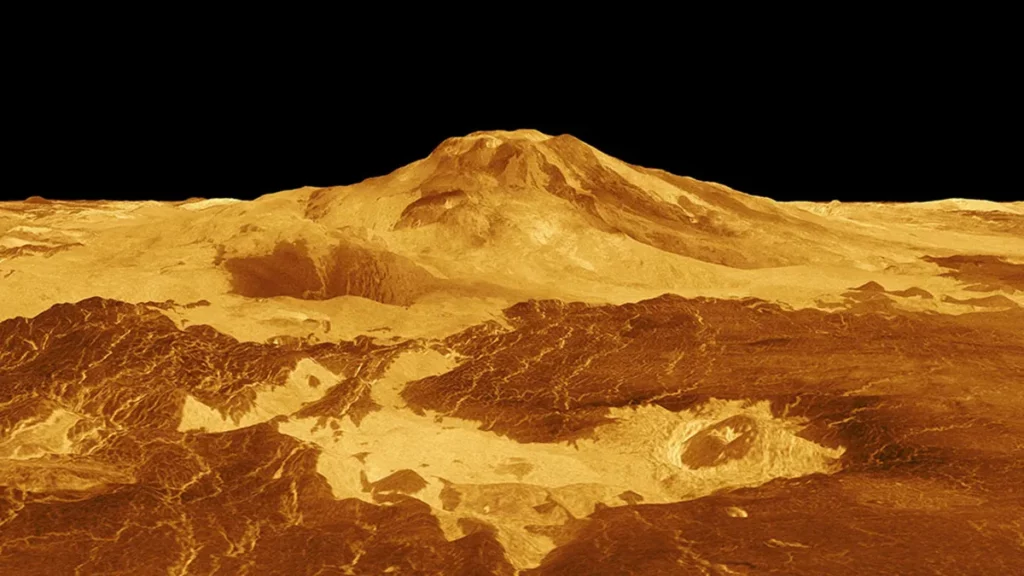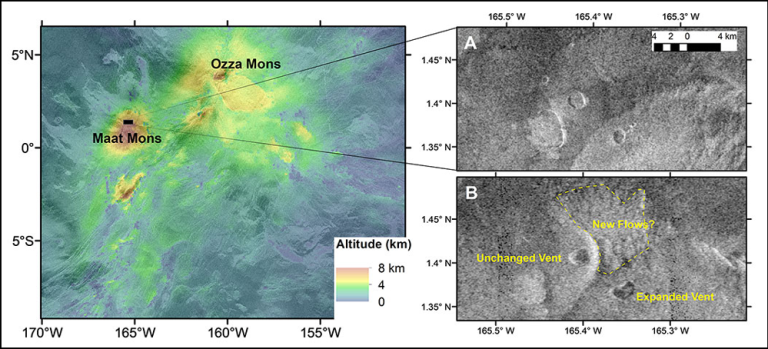
Often called Earth’s sibling owing to its similar mass and size, Venus differs from our planet in a key way: Roughly 80% of its surface is made of volcanic rock. Despite a clear history of volcanism, only hints of current activity have been found, including relatively young lava flows and whiffs of volcanic gases in the atmosphere. Now, researchers have identified what looks like an eruption that occurred 30 years ago, captured in images from NASA’s Magellan spacecraft.
Old Data, New Discovery
Between 1990 and 1992, Magellan mapped the entire surface of Venus using synthetic aperture radar at a resolution of 100–300 meters (300–1,000 feet). In a search of active volcanism, Robert Herrick, a planetary scientist at the University of Alaska Fairbanks, and Scott Hensley, a radar scientist at NASA’s Jet Propulsion Laboratory, looked through the immense data set for surface changes in areas suspected to have ongoing volcanic activity.
This search hadn’t been done before because the task requires computing power and software that weren’t available until recently. “Basically, you need to be able to load in a few hundred-gigabyte data sets and be able to pan around and zoom in and out,” Herrick said. He compared the software they use to a planetary scientist’s version of Google Maps. “That sort of software and hardware capability for someone using a desktop computer didn’t really come into being until the last decade.”
Magellan didn’t make it easier on the researchers. The spacecraft recorded the images from a highly elliptical orbit, resulting in varying resolutions and observing angles. This lack of consistency makes automated search processes almost unusable and forced the researchers to manually look for changes between images.
While zooming around the Venusian surface, the researchers looked for topographic changes between images acquired several months apart. Finally, they found a volcanic vent that clearly changed shape on the northern slope of Maat Mons, the largest volcano on Venus, with a total height of 9 kilometers (6 miles).

In the first image, the vent appears as a steep-walled circular pit around 175 meters (575 feet) deep, with an area of 2.2 square kilometers (roughly 0.8 square mile). In the second image, taken 8 months after the first, the vent had increased in size and acquired a bean shape, with a surface of 4 square kilometers (1.5 square miles). It also looks as if the vent had been filled with what appears to be a lava lake, the researchers said.
Once Herrick and Hensley spotted the changes in the pit, they built 3D models of the feature to rule out a false positive caused by the varying perspectives of the different images. They used the relative positions of several features in the landscape to calculate the topography around the pit and give the images a viewpoint directly above the apparent volcano, making it easier to compare images.
They also simulated how the reconstructed feature would appear in radar observations, revealing that no perspective changes could explain the variation between the earlier and later images. “We concluded there’s no way that the radar imaging geometry could account for the change in the imaging that we saw,” Hensley said.
“We very strongly believe that we have a real change in the surface of Venus.” The researchers presented their findings at the 54th Lunar and Planetary Science Conference on 15 March and in a study published in Science.
The images also revealed what appears to be a newly emerged lava field downslope from the pit. Unfortunately, the area isn’t clearly visible in the first image because of the angle of the spacecraft when it was acquired, so it’s possible this landform was already there in the first pass, the researchers said.
Even if lava didn’t reach the surface, the clear change in the shape of a large volcanic pit is the first morphological evidence for ongoing volcanic or magmatic activity on Venus, said Paul Byrne, a planetary geologist at Washington University in St. Louis who wasn’t involved with the study.
“It’s entirely possible that magma moving in the subsurface could lead to the same result,” he said. “Think basically what happened at Kīlauea in 2018, when a body of magma moved downhill inside the volcano, erupting near the base, destroying homes, and leaving behind a much larger summit caldera. In my view, that’s what’s happened here on Venus.”
The Smoking Gun
An active volcano is the missing piece of Venus’s geological puzzle. Its dearth of impact craters suggests that the surface is strikingly young. For a long time, scientists assumed that the planet suffered some sort of cataclysm about 500 million years ago in the form of intense volcanism that rapidly resurfaced the whole planet, which then became geologically dormant.
But recent theories depart from this static view of Venus. Byrne and others have shown that the surface of Venus is covered by tectonic features—faults, folds, and fractures—that point to ongoing, albeit regional, processes.
Because Venus lacks plate tectonics, these processes could be driven by mantle convection, which forms mantle plumes similar to those that power hot spot volcanism on Earth in places far from plate edges, such as Iceland and Hawaii.
“The reason this finding is important is because although there are lots of circumstantial evidence for ongoing volcanism, we’ve never seen a ‘smoking gun,’” Byrne said. Because the discovery “is the closest we’ve come to confirming something we’ve long assumed—and used as the rationale for new missions—[it’s] a big deal.”
“As we seek to understand that history and the future of our own planet,” said Lori Glaze, NASA’s Planetary Science Division director, “studying Venus and unlocking new findings about its evolution can help us understand our own home.” Additionally, “the more we learn about the characteristics of the planets in our backyard, including Venus, the more we can apply to understand distant exoplanets,” she added.
This article originally appeared in Eos Magazine.






